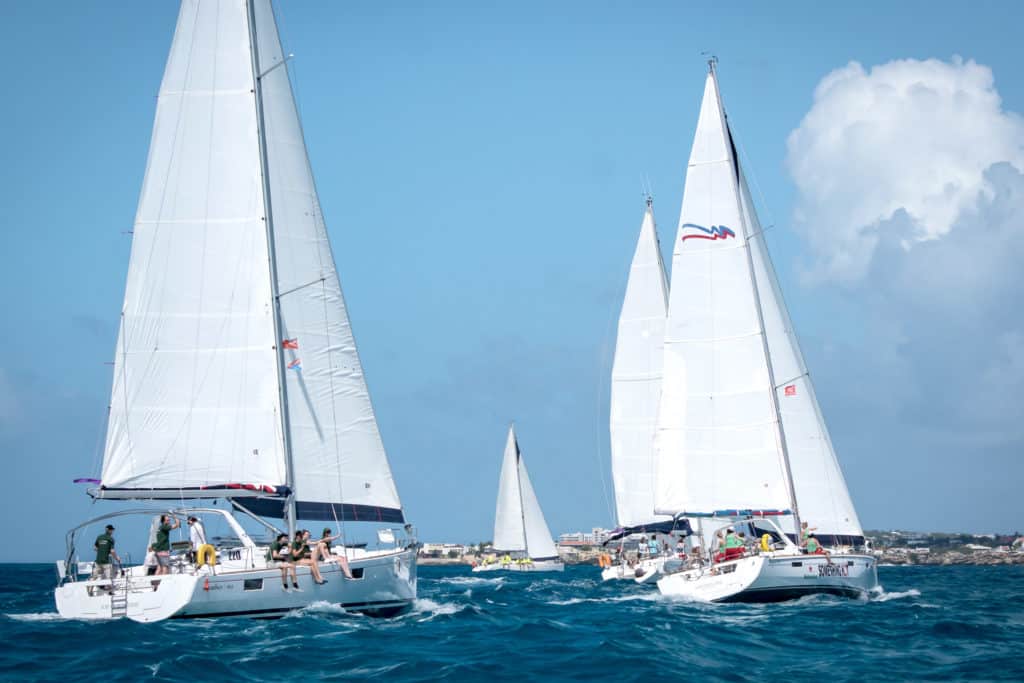
It was an early Thursday evening in the beginning of March at the St. Maarten Yacht Club, on this occasion perhaps the busiest watering hole in the entire Caribbean. The club’s two bars were packed three deep, and it was impossible to find a place to stand on the deck overlooking the water. As the clock ticked ever closer to 1730, the sense of anticipation and excitement was almost palpable. When the moment arrived, nearby vehicular traffic came to a standstill and everyone at the yacht club turned their attention seaward, ready for the show to begin. The bridge at the entrance to the Simpson Bay Lagoon was opened for business.
And the moveable feast of what amounted to an amazing boat parade commenced.
The next morning, the 37th running of the St. Maarten Heineken Regatta would begin. Many of the boats coming back to the lagoon were flat-out racers returning from competition in a pre-regatta series called the Gill Commodore’s Cup. Others were bareboat charter craft that would be competing in the Heineken, coming back from a day of practice. Then there were the cruising boats, many of which would also be racing against one another in a special division for cruisers called the Lottery class. A superyacht or two slipped through, as well as a fleet of state-of-the-art catamarans. If you love boats, it was a treat for the eyes.
The crews, many wearing costumes, hula skirts or crazy hats, were a big part of the spectacle. So were the self-appointed “judges” stationed at the club’s railing, who hoisted placards scoring the boats, much like the judges at an Olympic figure-skating competition: 10, 8, 5 and so on. It was all quite a scene. The Heineken Regatta’s motto is “serious fun,” an apt description of the annual happening that blends terrific on-the-water competition with memorable shoreside parties and live music, which attract not only the racers but seemingly the entire population of St. Maarten. There’s nothing else quite like it in the sailing world.
Standing at the bar, I set down an empty green bottle of the sponsor’s finest suds and picked up a cold, full one. Having escaped the New England winter, I’d flown down to St. Maarten and nabbed rides for all three days of the regatta, two of which were aboard different bareboats and the third on a Swan in the cruising class. After the last of dozens of boats passed into the lagoon and the bridge was lowered, I paid my tab and headed for my hotel. The forecast called for three days of big trade-wind breezes, and I wanted to be prepared. I couldn’t have been more psyched. I was in the Caribbean and totally ready to go sailing.
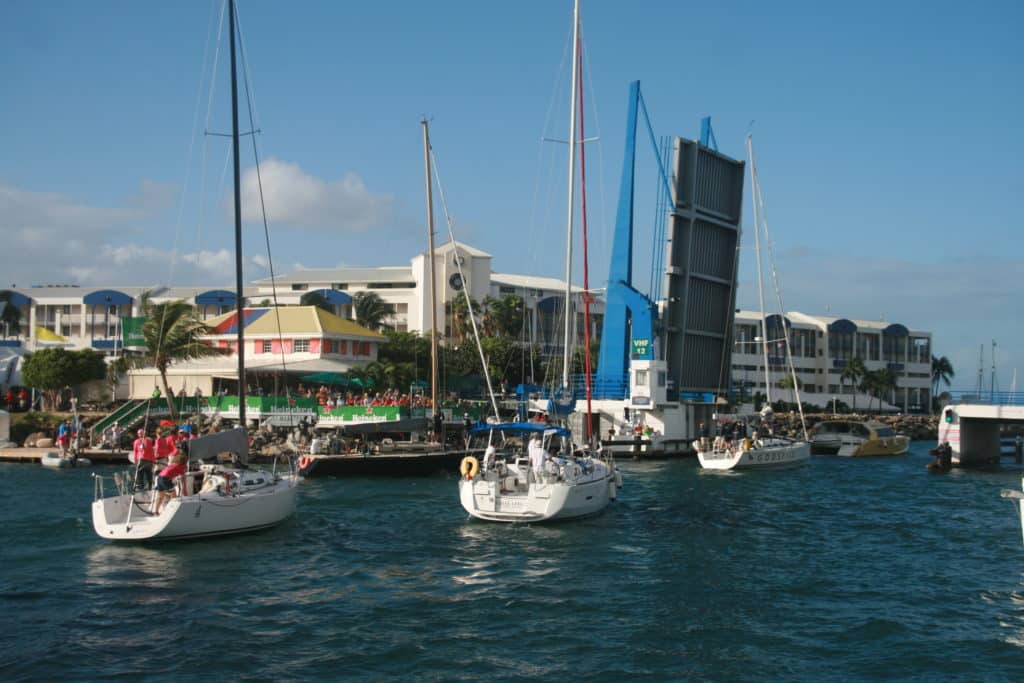
Oh, Canadians
Along with the hardcore racing sailors, charterers have always played a major role in the St. Maarten Heineken Regatta. For 2017, more than a quarter of the 164-strong fleet — 45 boats, racing in three dedicated divisions according to size — were bareboats. When conditions allow, which is almost always, the first day of competition is the eventful round-the-island race, a roughly 30-nautical-mile dash that offers a bit of everything: great scenery, big wind and waves, some close-quarters tacking duels and plenty of power-reaching. Given the racecourse, I was quite pleased to be joining a veteran, mostly Canadian crew aboard the Sunsail Sun Odyssey 509 Team Lake Effect. The “Lakers” had been here before, in 2016, and it seemed apparent from the moment I stepped aboard that they were a vastly experienced bunch. “There are lots of Canadians down here,” said one crewmember. “We want to get out of the weather!”
The previous evening, during registration at the yacht club, I’d pigeonholed Mike Lahrkamp, adorned in a snappy Team Lake Effect crew shirt (“Life Is Simple: Eat, Sleep, SAIL”), and asked him about coming along. As Canadians rank among the world’s nicest people (with my race program identifying boats and nationalities in hand, approaching Mike wasn’t an accident), he seemed open to the idea, but was insistent that he’d need the entire team to sign off on it. After a couple of subsequent beers with the crew, Mike said he’d get back to me shortly via email, and a few hours later I received word that I’d passed muster and had a slot. It was welcome news.
Day One of the regatta dawned clear and breezy, ideal conditions for the sprint around St. Maarten. “Boat call” was bright and early, at 0700, in order to have plenty of time for the bridge opening at 0800. At the IGY Marina in Simpson Bay, the familiar tune of whistling wind and slapping halyards rose to a crescendo. The forecast was for sustained easterly breezes of 25 knots, with gusts into the 30s. It was going to be a sporty Caribbean day.
As we motored out to the racecourse, I had time to meet the crew of Team Lake Effect, which was competing in the Bareboat 1 class for 50-foot charter boats. My initial hunch was correct; they were a seasoned group of sailors, all with fairly extensive racing resumes. Most were members of the Etobicoke Yacht Club in Toronto, aka “the friendliest yacht club on Lake Ontario.”
Mike sailed a Beneteau First 40. Bruce Moffitt was the skipper of a Hunter 40. Mac McLenzie campaigned a C&C 37. Karen Montazeri raced a Hobie 33 with her mom. Les Wardrop was the captain of a Tartan 10.1. Stephanie Burgess, the lone American, owned a Sabre 28 she kept in Buffalo. The rest of the team — Elizabeth Patty, Michelle Wardrop and Gerd Jan van der Hoek — didn’t own yachts but spent plenty of time crewing on their mates’ boats.
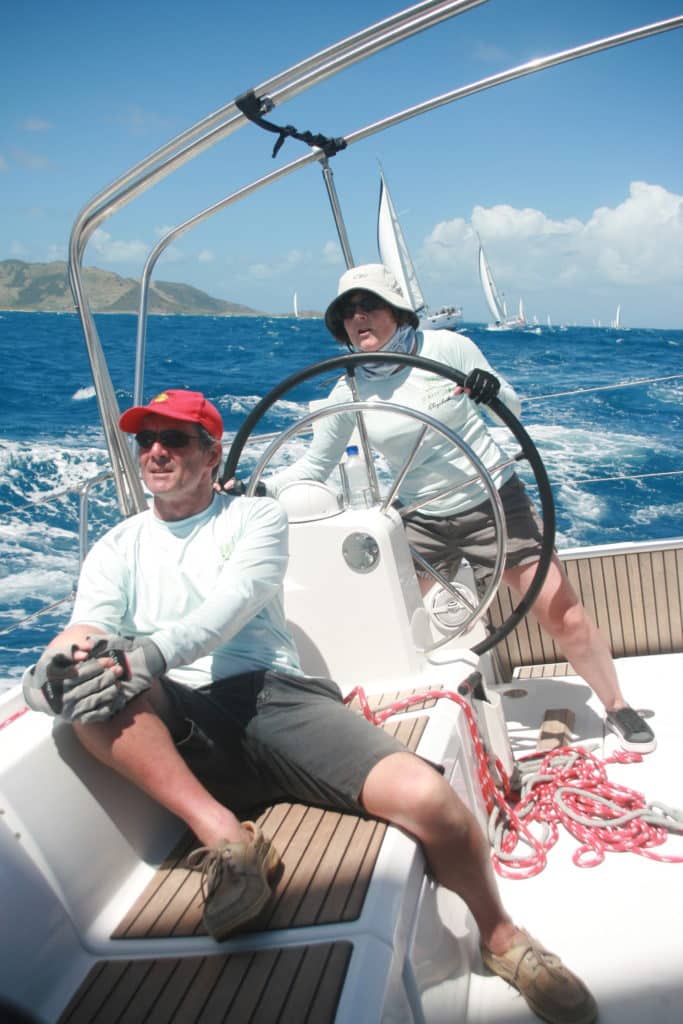
“Sailing is just part of our lives,” said Stephanie, “even though we don’t do it for a living.”
“We race with each other and against each other,” said Bruce.
“You might notice we have a lot of Type A personalities,” said Les.
“We’re all skippers,” said Mac. “That’s actually one of our concerns!”
I could see what he meant. If too many cooks spoil the broth, too many captains might be equally problematic for the same sort of reasons.
Take the first matter of business: to reef or not to reef. We’d tucked one in to the main at the dock, but once we made our way to the starting area, Mike called for a full hoist. “We can always put it back in later,” he said. Up went the full main. And on came the VHF radio. With the gargantuan, 289-foot, three-masted Maltese Falcon serving as the focal point to the windy, white-capped scene, the race committee hailed the fleet with this announcement: “It’s going to be a downwind start. Welcome to the Caribbean!”
Bruce took the wheel for the start, and he nailed it, approaching on port tack and jibing quickly to starboard moments after the gun sounded. Our course was indeed dead downwind, and Team Lake Effect began gobbling up the miles along the southern flank of St. Maarten at better than 9 knots. On our hip was another Sunsail 50-footer called Texas Two Step. The racing was close and fast: We’d gain a boat length or two, and the Texans would surge back and ahead. On it went as we slipped along the coast, reveling in the perfect conditions.
As we rounded the bottom mark and came closehauled up the Anguilla Channel, a rather spirited debate ensued, weighing the merits of holding an offshore board or tacking inshore and out of the current. Mike was dead set against the latter option, where Team Lake Effect was becalmed a year earlier. In the end, he won the battle and we put the reef back in as we continued bashing into the rather large seas and buffeting winds in the center of the channel. Only later did I discover it was a mistake.
At the northern end of St. Maarten, off the tiny isle of Tintamarre, we rounded the second and last mark of the course and cracked off to a close reach. Flying down the eastern side of the island in the Atlantic Ocean, we were passed by the French Volvo 70 SFS II, in the midst of a record-breaking lap of St. Maarten in 2 hours, 10 minutes. I thought we were doing pretty well, making nearly 10 knots, but they sped by like we were still in the water.
You hear some pretty interesting tales sitting on the rail of a racing boat, and on the final stretch of the race, Bruce related a beauty. Years earlier, his dad had built a 40-foot Lock Crowther-designed cat and set off to sail around the world with his family. Once in Puerto Rico, they took off for Europe, and all was well until 170 nautical miles later one of the hulls sheared off. They spent a long day and night clinging to the remaining hull until the Coast Guard arrived and whisked them all to safety.
It would be several years before Bruce’s mom stepped foot on another yacht, and when she did, she insisted it was a production boat and not something out of Dad’s garage. Sounds like a smart woman. After that story, the finish seemed anticlimactic. And our ninth-place finish in a class of 13 boats wasn’t necessarily anything to write home about. But back in the slip, the beer was cold and the postmortem recap of our day on the water was fun and lively. You don’t always have to win the race to have a good time. Sometimes, it’s more than enough to sail well and win the party.
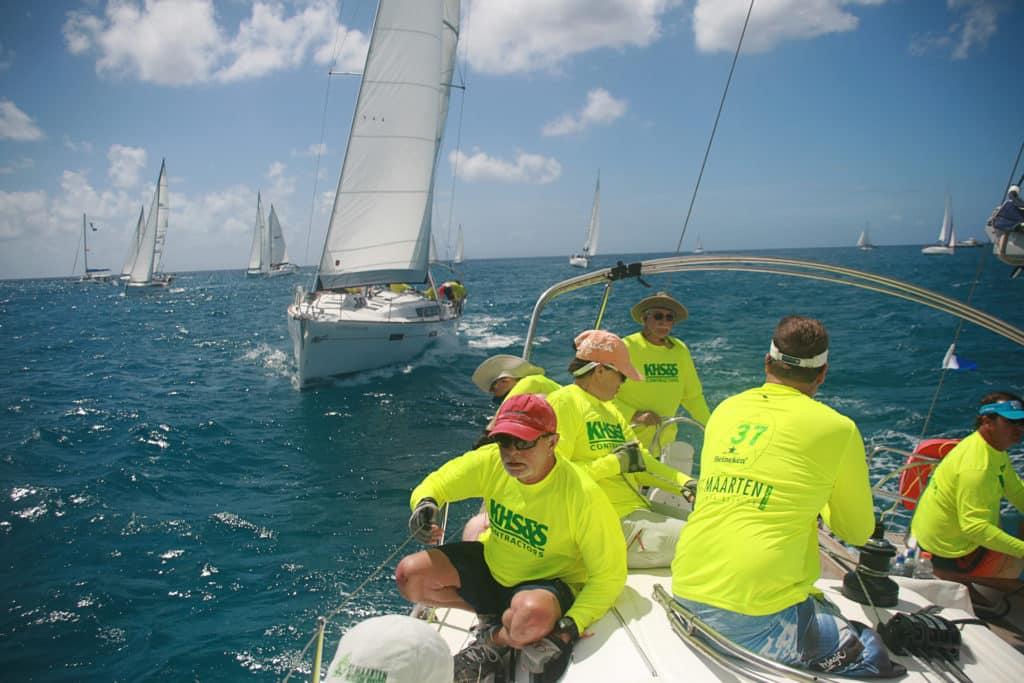
An Aussie and Friends
F or Day Two of the regatta, I’d scored a berth aboard KSH&H Contractors, with the one and only Neil “Harvs” Harvey in command. A consummate Aussie and a longtime sales representative for Harken hardware, Harvs is a throwback to the golden age of yachting, having competed aboard the famous racing yacht Kialoa III back in the 1970s, as well as the Gretel and Southern Cross campaigns — both Australian — for the America’s Cup.
I knew I was in for a unique experience when I stepped aboard the Dufour 455 and saw a wheelchair, which belonged to Brad Kendell, a silver-medal winner at the 2016 Paralympic Games who lost his legs in a plane crash that took the life of his dad, Bruce, in 2003 (see “Off Watch,” May 2017). Bruce and Harvs had both been hands aboard Kialoa III, and it would soon be clear that Harvs was enjoying sailing with his late pal’s son. The rest of the crew was also formidable, and included Mike Cannon and Al Gooch — more of Harv’s mates, who annually wreaked havoc together sailing chartered bareboats in Caribbean regattas — and Florida sailmaker Colin Mack. Also on board, sailing for the first time with his dad, was Harv’s son, Sean, a strapping young lad who’d played football at the University of Miami.
Harvs has bareboat racing down to a science; he’s compiled a 22-point list of tips, tools and techniques he passes out to the crew and employs for every regatta. He even leaves a duffel bag full of blocks, tape and other hardware — it pays to work for Harken — in the Caribbean so he can replace tired equipment. Among some of his pointers: Lead the jib furling line to the cabin top to avoid having to use the primary winches to furl a sail. Never lock down the traveler in the self-tailer; instead, have two trimmers working it at all times to dump the main in gusts and trim it in lulls. Unless it’s blowing a gale, never reef the main. When the breeze is on, furl the headsail a turn or three to reduce overlap with the main; it’s less prone to backwind the mainsail and opens up the slot between the headsail’s leech and the main. Leave the engine in neutral under sail; free-spinning a three-bladed prop is the fastest way to go. Gather all fenders and dock lines in a sail bag and stash them under the saloon table, where they’re out of the way and their weight is low and centered. The list goes on and on.
And it must work. On the round-the-island race the day before, KSH&H Contractors — sailing in the Bareboat 3 division — smoked the entire fleet, beating many of the 50-footers that started ahead of them in the process. (Notably, unlike Team Lake Effect, Harvs played the shore up the Anguilla Channel, short-tacking along the coast in 18 feet of water and staying out of the stronger current offshore.)
I knew Harvs had given it all a lot of thought when we went to hoist the main and he put the boat slowly in reverse, something I hadn’t seen before. But it made perfect sense: Not only did it reduce the apparent wind and make for a very civilized maneuver, it also cleared any seaweed off the rudder or keel. Genius!
The race committee had scheduled a pair of races that day for the three Bareboat classes, the first of which was canceled after the start when it became apparent that the windward mark had either not been set or had drifted away. Hey, it’s the Caribbean, mon! The second, a long beat up the south and east coasts of the island, followed by a downwind run to the finish, got underway in similar conditions to the previous day. In other words, the dogs were being blown off the chains.
It wasn’t a problem on KSH&H, though. On the mainsheet, Colin had the big sail trimmed perfectly. Up on the coachroof, Brad never once locked down the traveler, playing it up and down depending on the wind strength at any given moment. The boat remained on a constant heel, never once standing up or heeling excessively, always in phase. “Beautiful work, mate,” marveled Harvs.
Once we rounded the top mark and eased off to a run, the good times continued to roll. Sailing wing and wing, the crew tied off the main directly to the cap shroud, a simple and effective preventer that was again a new one on me. And Harv’s boy, Sean, the ex-football stud, did a fine job serving as a human whisker pole, keeping the genoa full as we flew down the coast. It was the first time father and son had ever sailed in a regatta together. Clearly, both lads were having a ball.
After crossing the finish line, in preparation for the bridge opening back into Simpson Bay, a box of hard hats appeared — KSH&H Contractors, get it? — and the team put them on for the ride back to the slip. After yet another first-place finish (there would be another the next day, ensuring that Harvs and his mates would take the prize as the regatta’s best bareboat overall), it seemed appropriate. It had been another workmanlike effort.
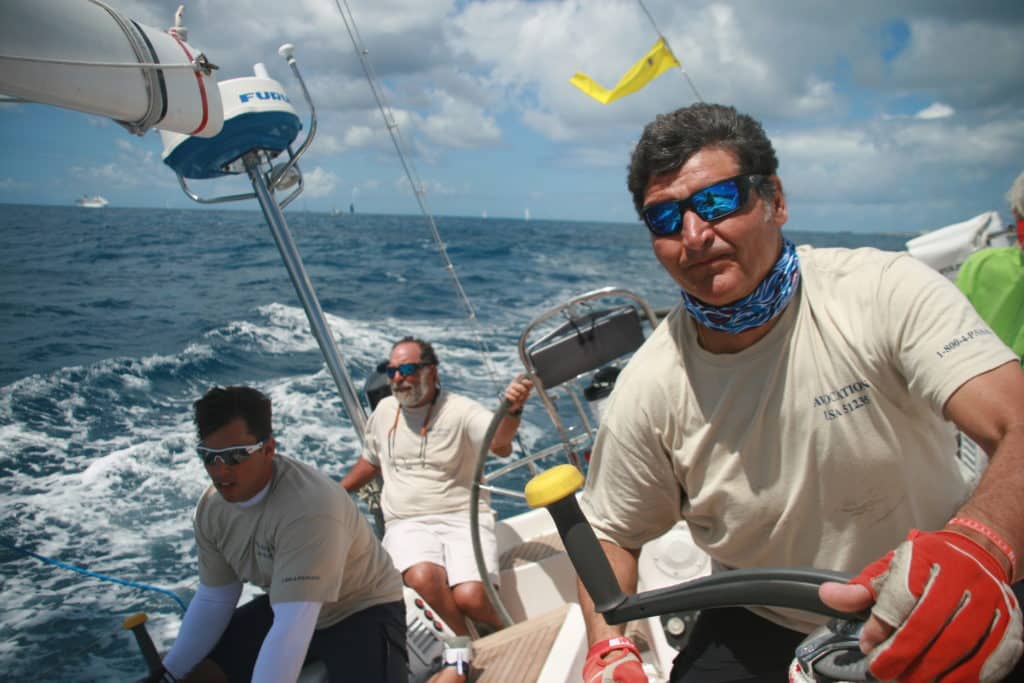
Playing the Lottery
W elcome to the Lottery class!” said Hank Schmitt as I stepped aboard his Swan 48, Avocation, on the third and final day of the Heineken Regatta. The Lottery class, I’d soon learn, was a misnomer. With a 12-boat fleet including a pair of Beneteau 50s, as well as a Catalina 470, a Jeanneau 57, a C&C 41, a Contest 36, an Alden 50 and an Outbound 44 — many of them still equipped with dedicated voyaging gear, such as dodgers, solar panels and wind generators — it was really the “cruising” class.
Schmitt, a sailing entrepreneur who runs Offshore Passage Opportunities (OPO), a service that pairs would-be distance sailors with skippers looking for crew, had sponsored the class with the aim of attracting more of the hundreds of cruising boats wandering about the Caribbean each winter to join the regatta. To that end, he’d arranged a later bridge opening each morning for the cruisers, shorter courses and dedicated parties at the end of each day. For a decade, Schmitt had competed in the Grand Prix race divisions, but he was now more interested in spending less dough on racing sails and equipment and more time enjoying low-key competition and camaraderie. He was taking the notion of “serious fun” very seriously.
Nine sailors had signed on to sail aboard Avocation — all OPO members who’d raced with Hank previously or undertaken delivery trips with the organization — and it was clear they were all up for a good time. After meandering out to the racecourse at the quite reasonable hour of 1100, we started our race in a diminished breeze of 8 to 10 knots. It was all very civilized.
I’d be lying if I said I was keeping close track of who was ahead and behind, or even who finished first at the end of the day. Aboard Avocation, the vibe was mellow and the laughs were frequent. If Hank’s aim had been to supply all the ingredients for several fun days on the water, he’d succeeded in spades.
That mood continued on for the rest of the day and into the night, right up through the appearance of the British reggae band UB40 at the concluding bash and awards ceremony on Kim Sha Beach. For the 37th year in a row, the St. Maarten Heineken Regatta had dished up a fine blend of big winds, friendly competition and world-class parties. And the best thing of all about the Heineken Regatta? They’ll do it again next year.
– – –
Herb McCormick is CW’s executive editor.








